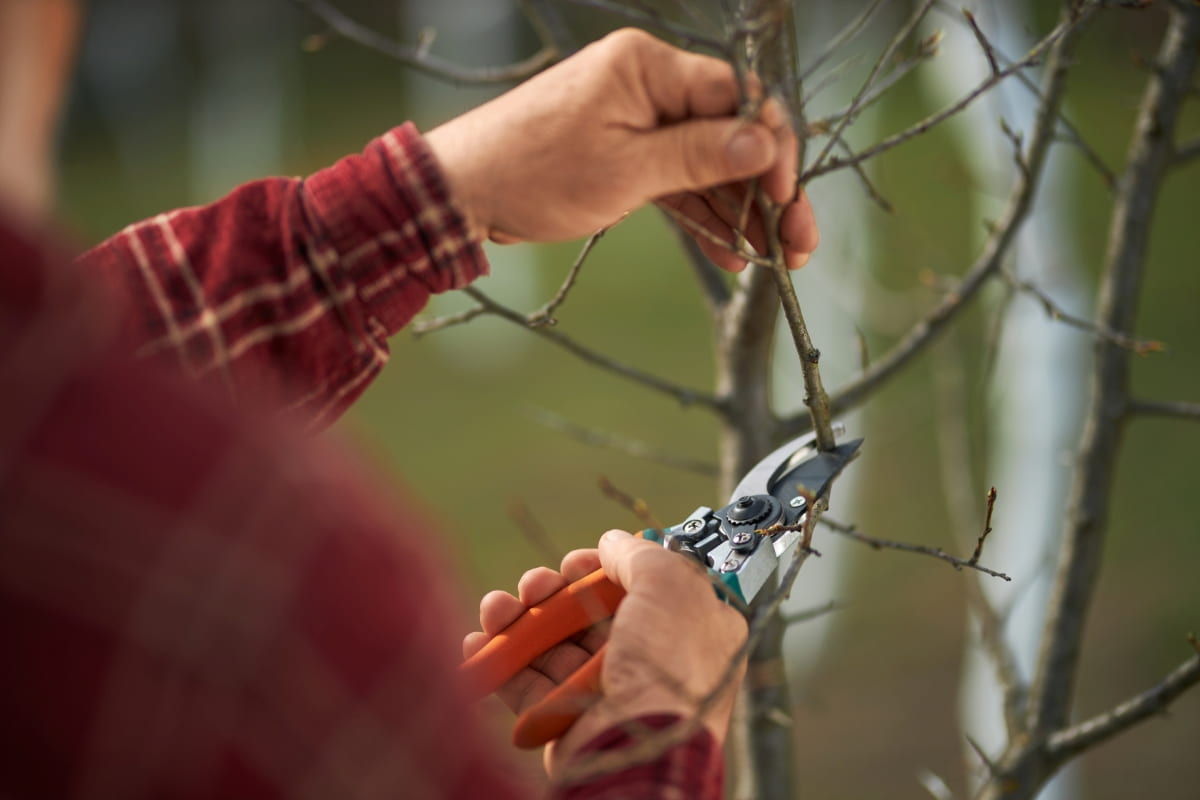Pruning plum trees is an essential task to maintain their health and productivity. Trimming them properly can encourage new growth, improve fruit production, and prevent disease. In this guide, we will cover the best time to trim plum trees, the tools you will need, and the techniques to cut back these trees effectively.

Understanding the Basics of Pruning Plum Trees: A Step-By-Step Guide
Pruning plum trees is an essential practice for maintaining their health and promoting proper growth. It involves removing specific branches or parts of the tree to improve its overall structure and productivity. The main objectives of pruning are to stimulate new growth, increase fruit production, enhance air circulation, and prevent disease. Care should be taken to maintain a balanced shape and avoid excessive pruning, as it can negatively impact the tree’s ability to bear fruit. Regular and proper pruning will ensure healthy and productive plum trees.
The Best Time to Prune Plum Trees: A Comprehensive Overview
What month do you prune plum trees? The best period to prune plum trees is in late winter or else early spring before new growth begins. Pruning during this dormant period helps stimulate healthy growth and maintain the tree’s shape. It is important to avoid pruning during late autumn or early winter, as this can leave the tree vulnerable to diseases and pests. When pruning, cut the dead or damaged branches first and then thin out overcrowded ones for better air circulation. Regular pruning promotes better fruit production and overall tree health.
How to Properly Trim Plum Trees for Optimal Growth and Fruit Production
To properly trim plum trees for optimal growth and fruit production, start by removing any dead, diseased, or damaged branches. Next, thin out the tree by cutting back branches crossing or rubbing against each other. Aim to create an open and well-spaced structure that allows sunlight and air circulation.
Prune back the previous year’s growth by cutting back one-third of the length of the branches. This will encourage new growth and increase fruit production. Lastly, remove any water sprouts or suckers that grow from the tree’s base. Regular pruning helps maintain the health and productivity of plum trees.
Step-By-Step Instructions on When and How to Prune Plum Trees
Determine the right time: Puning plum trees in winter or else early spring before new growth starts is the best time. This is typically between February and March, depending on your location and climate.
Gather the necessary tools: To cut back your plum trees properly, you will need a pair of sharp bypass pruning shears, loppers for thicker branches, a pruning saw for larger limbs, and gardening gloves for protection.
Identify diseased or damaged branches: Inspect your plum tree for any dead, broken, or diseased branches. These should be removed first to prevent further damage and promote healthy growth.
Trim the branches: Begin by pruning the longest branches to help maintain the tree’s shape. It allows sunlight to reach all parts of the tree. Cut back branches at a 45-degree angle, about a quarter-inch above an outward-facing bud or side branch.
Maintain the central leader: Plum trees have a central leader, the main upright stem. Prune any side branches that compete with the central leader, ensuring it remains the tree’s tallest and strongest part.
Remove excessive growth: Thin out crowded branches to improve air circulation and reduce disease risk. Remove your plum tree branches that are crossing or rubbing against each other.
Clean up and dispose of cuttings: Collect and remove all pruned branches and debris around the tree. This prevents diseases and pests from spreading.
In case you missed it: How to Grow Plum from Seed: How Long Does it Take for a Plum Seed to Grow?

Pruning Plum Trees: Essential Tips and Techniques for Beginners
- Equipment: Use clean and sharp pruning tools to make precise cuts without damaging the tree.
- Remove Dead and Diseased Wood: Identify and cut off any dead or diseased branches to promote tree health.
- Thin Out Overcrowded Branches: Remove branches crossing or crowding each other to improve air circulation and sunlight penetration.
- Maintain the Tree’s Shape: Prune to maintain a balanced and open structure, allowing for even fruit distribution.
- Cut at a 45-Degree Angle: Make clean cuts just above a bud or lateral branch, angled away from the tree’s center.
- Avoid Over-Pruning: Don’t remove over one-third of the tree’s total growth in a single pruning session.
- Regular Maintenance: Prune plum trees annually to control size, encourage fruit production, and prevent disease.
- Observe Proper Sanitation: Dispose of pruned branches, leaves, and debris to prevent pests and diseases from spreading.
- Seek Expert Advice: If unsure, consult a professional arborist or horticulturist for guidance on specific pruning techniques.
Maximizing the Health and Productivity of Your Plum Trees Through Pruning
Pruning plays a crucial role in maximizing the health and productivity of plum trees. By removing dead, diseased, or damaged branches, pruning prevents pests and diseases from spreading. It also allows for better air circulation and sunlight penetration, promoting overall tree health.
In case you missed it: 9 Causes of Dying Plum Trees and How to Fix Them?

Additionally, pruning helps to shape the tree, ensuring a strong and balanced structure. This, in turn, enhances fruit production and quality. It is important to prune plum trees during the dormant season, usually in late winter or else early spring. Regular pruning, done correctly, can greatly benefit the health and productivity of your plum trees.
Timing is Key: Knowing When to Prune Your Plum Trees for Maximum Yield
Timing is vital to the success of your pruning efforts. Knowing when to prune your plum trees is key to ensuring maximum yield. The best time to prune plum trees is during their dormant season, typically in late winter or early spring. Pruning during this period offers several advantages. Firstly, when the tree is dormant, it is less susceptible to stress and damage caused by pruning.
Additionally, without leaves, it becomes easier to assess the tree’s overall structure and identify any diseased or damaged branches that need to be removed. During the dormant season, you should aim to prune your plum trees before the buds swell or break open. This timing allows the wounds from pruning to heal quickly once the tree enters its growing season.
Pruning too late in the spring can lead to excessive sap flow, making the tree vulnerable to diseases and pests. Another important consideration is to avoid pruning plum trees during the fall. Pruning during this time can stimulate new growth, which is more susceptible to winter damage. It is best to wait until the tree has entered its dormant phase before engaging in any pruning activities.
How to Safely Prune Plum Trees: Tools, Techniques, and Safety Precautions
To safely prune plum trees, you will need a few essential tools. These include pruning shears for cutting small branches, loppers for thicker branches, a pruning saw for larger limbs, and a pole pruner for high branches. It’s important to choose high-quality, sharp, clean tools to ensure the safest and most effective pruning process. Techniques for pruning plum trees involve removing dead, diseased, or crowded branches. Start by trimming off dead or damaged branches, ensuring to cut just above the branch collar.
In case you missed it: How to Increase Flowers in Plum: Explained in 10 Simple Steps for Higher Yield and Profit

To promote new growth and maintain the tree’s shape, thin out crowded areas by removing smaller branches. Lastly, prune any branches that cross or rub against each other. Safety precautions should never be overlooked when pruning plum trees. Wearing safety glasses and gloves is recommended to shield against potential injuries. Be mindful of electrical lines when using ladders or tools near the tree. It is also advisable to have someone nearby in case of an accident or emergency.
Conclusion
By following the above-discussed guidelines, you can effectively prune plum trees and promote their overall health and productivity. Regular pruning will keep your plum trees in top shape and ensure a bountiful harvest for years.
- Feed Your Flock for Less: Top 10 Tips to Save on Chicken Feed
- Ultimate Guide to Ossabaw Island Hog: Breeding, Raising, Diet, and Care
- Hatching Answers: The Top 10 Reasons Your Chickens Aren’t Laying Eggs
- Eggs and Economics: Breaking Down the Cost of Raising Backyard Chickens
- Defend Your Greens: Proven Methods to Keep Iguanas Out of Your Garden
- Ultimate Guide to Cinnamon Queen Chicken: A Comprehensive Guide for Beginners
- Ultimate Guide to California Tan Chicken: Breeding, Raising, Diet, Egg-Production and Care
- Ultimate Guide to Marsh Daisy Chicken: Breeding, Raising, Diet, and Care
- 10 Types of Chicken Farming Businesses You Can Start for Profits